Do you have a question about the MOTO GUZZI NORGE GT 8V and is the answer not in the manual?
Provides an overview of the manual's purpose and vehicle usage guidelines.
Details risks and precautions regarding exhaust fumes and carbon monoxide exposure.
Covers flammability, explosive risks, and safe handling procedures for fuel.
Explains the meaning and action required for various dashboard warning lights.
Provides guidelines for the safe handling and disposal of used engine and gearbox oil.
Highlights risks associated with brake and clutch fluid, including skin and eye contact.
Details hazards of battery electrolyte and hydrogen gas, including handling precautions.
Instructions for using the side stand and ensuring the vehicle's stability.
Advises on not disassembling components and cautioning about connector interchangeability.
Identifies and labels the primary components of the motorcycle with a diagram.
Details the location of controls and instruments on the dashboard with a diagram.
Explains the analog instrument panel, including the multifunction display and gauges.
Lists and describes the meaning of all indicator lights on the motorcycle's light unit.
Describes the digital LCD display's startup sequence and standard settings.
Explains how to use the control buttons for menu navigation and data selection.
Details how to access and navigate advanced functions like SETTINGS, DIAGNOSIS, and LANGUAGES.
Explains how to view battery voltage and notes that no user interaction is possible.
Describes the service wrench icon appearing on the display for maintenance intervals.
Explains how the vehicle displays critical alarms and categorizes them by priority.
Details the ignition switch functions for locking, OFF, and ON states, including key removal.
Provides steps to lock the steering wheel, including key positions and removal.
Explains how to activate the parking lights for visibility and safety.
Describes how to activate the horn using the button.
Details how to operate the turn indicators and the meaning of the flashing warning light.
Explains how to switch between high and low beam headlights and tail light operation.
Describes the use of the passing light button for emergencies.
Explains how to activate hazard lights and their behavior.
Describes how to use the starter button to engage the engine.
Details the function of the engine stop switch as an emergency cut-off.
Explains the ABS system's function to prevent wheel lock-up during emergency braking.
Provides instructions for deactivating and reactivating the ABS system.
Details the 12V power socket location and its usage limitations.
Covers fairing components and basic removal steps for access.
Instructions for opening, closing, and locking the vehicle's saddle.
Details access to the glovebox and toolkit compartment, including weight limits.
Guides on recording chassis and engine numbers and warns against modification.
Explains how to electrically adjust the windscreen height and cautions against simultaneous operation.
Details how to secure luggage using the rear seat anchor points and weight limits.
Details checks for front/rear brakes, throttle, and engine oil level.
Step-by-step guide on how to open the fuel cap, refuel, and close the tank.
Explains the rear suspension components and how to adjust rebound damping and spring preload.
Details how to adjust front fork preload and check suspension components.
Explains how to adjust the distance between the brake lever and handlebar.
Explains how to adjust the distance between the clutch lever and handlebar.
Details the importance of engine run-in for longevity and proper operation, including driving variations.
Provides guidelines for selecting safe parking spots and securing the vehicle.
Warns about the high temperature of the catalytic converter and parking near flammable materials.
Instructions for operating and maintaining the side and center stands.
Offers advice on securing the vehicle, including using disc locks and alarm systems.
Provides essential safety instructions for getting on and off the vehicle.
Explains how to use the heated handgrips for comfort and warmth.
Introduces routine maintenance, required tools, and the vehicle's self-diagnostic capabilities.
Provides instructions for checking the engine oil level and the conditions under which it should be done.
Details the steps for topping up engine oil, including removing the fill plug and checking the level.
Explains the process for changing engine oil and the oil filter, noting potential complexity.
Details the procedure for replacing the engine oil filter, including torque specifications.
Describes how to check the oil level in the cardan shaft transmission unit.
Advises contacting a dealer for gearbox oil checks, top-ups, and changes.
Explains how to check tyre pressure and wear, emphasizing safety and proper tyre conditions.
Guides on spark plug removal, inspection, cleaning, and replacement, referring to a workshop manual.
Details how to check the brake fluid level for front and rear brakes.
Provides instructions and cautions for topping up the braking system fluid.
Explains how to check the clutch fluid level and when to top it up.
Step-by-step instructions for safely removing the motorcycle battery.
Details how to connect a new battery, including terminal order and component reinstallation.
Provides instructions for removing the battery and connecting it to a charger.
Advises on disconnecting the battery and handling long periods of vehicle inactivity.
Explains how to check and replace fuses, warning against incorrect fuse usage.
Provides safety precautions for replacing bulbs, including cooling and handling.
Guides on adjusting the vertical aim of the headlights, including quick checks.
Details how to adjust the horizontal aim of low and high beam headlights.
Step-by-step guide for replacing bulbs in the front turn indicators.
Notes that the rear headlamp uses LEDs and replacement is recommended at a dealer.
Details how to replace bulbs in the rear turn indicators, with a caution on the lens.
States that number plate light replacement is complex and recommended for dealers.
Provides instructions for adjusting and removing rear-view mirrors, with safety cautions.
Warns about dirty discs affecting braking and details pad wear checks.
Guides on preparing the vehicle for long-term storage to prevent damage.
Provides detailed instructions for cleaning the motorcycle, including specific areas and cautions.
Provides instructions and cautions for safely transporting the vehicle, including fuel tank and gear selection.
Lists key dimensions and weight specifications for the vehicle.
Details engine type, cylinders, bore/stroke, displacement, compression, and starter.
Lists spark plug type and specifications.
Details chassis type, trail, steering angle, and front/rear suspension.
Lists specifications for front and rear brakes, including disc and caliper details.
Details wheel rim types, tyre types, and pressure specifications.
Details primary drive, gearbox, gear ratios, and final drive.
Lists the tools provided with the vehicle, including their sizes and types.
Explains the importance of scheduled maintenance and how to use the table.
Lists recommended oils, greases, and fluids for vehicle maintenance.
| Brand | MOTO GUZZI |
|---|---|
| Model | NORGE GT 8V |
| Category | Motorcycle |
| Language | English |
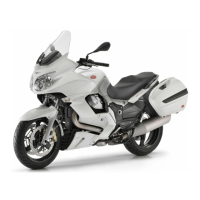
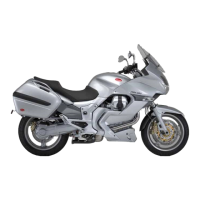
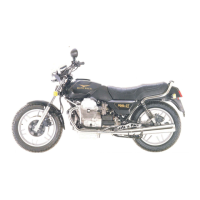
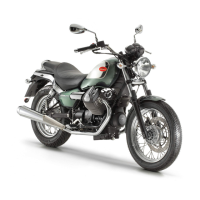


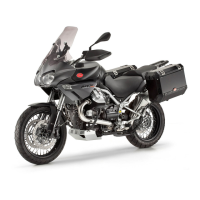
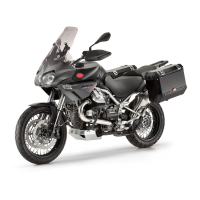
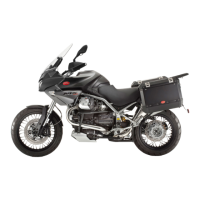

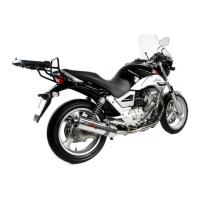
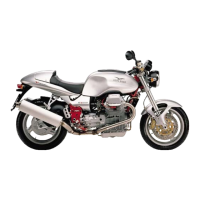
